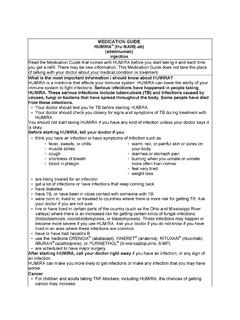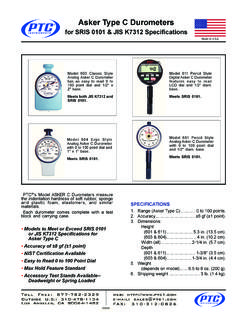Transcription of HIGHLIGHTS OF PRESCRIBING INFORMATION - …
1 HIGHLIGHTS OF PRESCRIBING INFORMATIONT hese HIGHLIGHTS do not include all the INFORMATION needed to use DUOPA safely and effectively. See full PRESCRIBING INFORMATION for (carbidopa and levodopa) enteral suspension Initial Approval: 1975 RECENT MAJOR CHANGESW arnings and Precautions, Gastrointestinal and Gastrointestinal Procedure-Related Risks ( ) 12/2019 INDICATIONS AND USAGEDUOPA is a combination of carbidopa (an aromatic amino acid decarboxylation inhibitor) and levodopa (an aromatic amino acid) indicated for the treatment of motor fluctuations in patients with advanced Parkinson s disease (1)DOSAGE AND ADMINISTRATION The maximum recommended daily dose of DUOPA is 2000 mg of levodopa ( , one cassette per day) administered over 16 hours ( ) Prior to initiating DUOPA, convert patients from all forms of levodopa to oral immediate-release carbidopa-levodopa tablets (1:4 ratio) ( ) Titrate total daily dose based on clinical response for the patient ( ) Administer DUOPA into the jejunum through a percutaneous endoscopic gastrostomy with jejunal tube (PEG-J) with the CADD -Legacy 1400 portable infusion pump ( )DOSAGE FORMS AND STRENGTHSE nteral Suspension: mg carbidopa and 20 mg levodopa per mL (3)CONTRAINDICATIONSDUOPA is contraindicated in patients taking nonselective monoamine oxidase (MAO) inhibitors (4)WARNINGS AND PRECAUTIONS Gastrointestinal procedure-related complications may result in serious outcomes, such as need for surgery or death ( ) May cause falling asleep during activities of daily living ( ) Monitor patients for orthostatic hypotension, especially after starting DUOPA or increasing the dose ( ) Hallucinations/Psychosis/Confusion: May respond to dose reduction in levodopa ( ) Impulse Control Disorders.
2 Consider dose reductions or stopping DUOPA ( ) Monitor patients for depression and suicidality ( ) Avoid sudden discontinuation or rapid dose reduction to reduce the risk of withdrawal-emergent hyperpyrexia and confusion ( ) May cause or exacerbate dyskinesia: Consider dose reduction ( ) Monitor patients for signs and symptoms of peripheral neuropathy ( )ADVERSE REACTIONSMost common adverse reactions for DUOPA (DUOPA incidence at least 7% greater than oral carbidopa-levodopa incidence) were: complication of device insertion, nausea, depression, peripheral edema, hypertension, upper respiratory tract infection, oropharyngeal pain, atelectasis, and incision site erythema. ( )To report SUSPECTED ADVERSE REACTIONS, contact AbbVie Inc. at 1-800-633-9110 or FDA at 1-800-FDA-1088 or INTERACTIONS Selective MAO-B inhibitors: May cause orthostatic hypotension ( ) Antihypertensive drugs: May cause symptomatic postural hypotension. Dosage adjustment of the antihypertensive drug may be needed ( ) Dopamine D2 receptor antagonists, isoniazid, iron salts, and high-protein diet may reduce the effectiveness of DUOPA ( , , ) USE IN SPECIFIC POPULATIONSP regnancy: Based on animal data, may cause fetal harm ( )See 17 for PATIENT COUNSELING INFORMATION and Medication : 05/2020 FULL PRESCRIBING INFORMATION .
3 CONTENTS*1 INDICATIONS AND USAGE2 DOSAGE AND DUOPA Daily Initiation and Titration Administration Discontinuation of DUOPA3 DOSAGE FORMS AND STRENGTHS4 CONTRAINDICATIONS5 WARNINGS AND Gastrointestinal and Gastrointestinal Procedure-Related Falling Asleep During Activities of Daily Living and Orthostatic Hypotension Hallucinations/ Impulse Control/Compulsive Depression and Withdrawal-Emergent Hyperpyrexia and Dyskinesia Neuropathy Cardiovascular Ischemic Laboratory Test Glaucoma6 ADVERSE Clinical Trials Experience7 DRUG Monoamine Oxidase (MAO) Antihypertensive Dopamine D2 Receptor Antagonists and Iron High-Protein Diet8 USE IN SPECIFIC Pediatric Geriatric Use10 OVERDOSAGE11 DESCRIPTION12 CLINICAL Mechanism of Pharmacokinetics13 NONCLINICAL Carcinogenesis, Mutagenesis, Impairment of Fertility14 CLINICAL STUDIES16 HOW SUPPLIED/STORAGE AND How Storage and Handling17 PATIENT COUNSELING INFORMATION *Sections or subsections omitted from the full PRESCRIBING INFORMATION are not listed.
4 FULL PRESCRIBING INFORMATION1 INDICATIONS AND USAGEDUOPA is indicated for the treatment of motor fluctuations in patients with advanced Parkinson s disease. 2 DOSAGE AND DUOPA Daily DoseDUOPA is administered over a 16-hour infusion period. The daily dose is determined by individualized patient titration and composed of: A Morning Dose A Continuous Dose Extra DosesThe maximum recommended daily dose of DUOPA is 2000 mg of the levodopa component ( , one cassette per day) administered over 16 hours. At the end of the daily 16-hour infusion, patients will disconnect the pump from the PEG-J and take their night-time dose of oral immediate-release carbidopa-levodopa tablets. Treatment with DUOPA is initiated in 3 steps [see Dosage and Administration ( )]: of patients to oral immediate-release carbidopa-levodopa tablets in preparation for DUOPA treatment. and administration of the DUOPA starting dose (Morning Dose and Continuous Dose) for Day 1. of the dose as needed based on individual clinical response and DosesDUOPA has an extra dose function that can be used to manage acute Off symptoms that are not controlled by the Morning Dose and the Continuous Dose administered over 16 hours.
5 The extra dose function should be set at 1 mL (20 mg of levodopa) when starting DUOPA. If the amount of the extra dose needs to be adjusted, it is typically done in mL increments. The extra dose frequency should be limited to one extra dose every 2 hours. Administration of frequent extra doses may cause or worsen dyskinesias. Once no further adjustments are required to the DUOPA Morning Dose, Continuous Dose, or Extra Dose, this dosing regimen should be administered daily. Over time, additional changes may be necessary based on the patient s clinical response and tolerability. Initiation and Titration InstructionsPrepare for DUOPA TreatmentPrior to initiating DUOPA, convert patients from all other forms of levodopa to oral immediate-release carbidopa-levodopa tablets (1:4 ratio). Patients should remain on a stable dose of their concomitant medications taken for the treatment of Parkinson's disease before initiation of DUOPA infusion. Healthcare providers should ensure patients take their oral Parkinson's disease medications the morning of the PEG-J procedure.
6 Determine the DUOPA Starting Dose for Day 1 The steps for determining the initial DUOPA daily dosing (Morning Dose and Continuous Dose) for Day 1 are outlined below. Step 1: Calculate and administer the DUOPA Morning Dose for Day the total amount of levodopa (in milligrams) in the first dose of oral immediate-release carbidopa-levodopa that was taken by the patient on the previous day. the oral levodopa dose from milligrams to milliliters by multiplying the oral dose by and dividing by 20 mg/mL. This calculation will provide the Morning Dose of DUOPA in milliliters. 3 milliliters to the Morning Dose to fill (prime) the intestinal tube to obtain the Total Morning Total Morning Dose is usually administered over 10 to 30 the pump to deliver the Total Morning 2: Calculate and administer the DUOPA Continuous Dose for Day the amount of oral immediate-release levodopa that the patient received from oral immediate-release carbidopa-levodopa doses throughout the previous day (16 waking hours), in milligrams.
7 Do not include the doses of oral immediate-release carbidopa-levodopa taken at night when calculating the levodopa amount. the first oral levodopa dose in milligrams taken by the patient on the previous day (determined in Step 1 (a)) from the total oral levodopa dosein milligrams taken over 16 waking hours (determined in Step 2 (a)). Divide the result by 20 mg/mL. This is the dose of DUOPA administered as a Continuous Dose (in mL) over 16 hours. hourly infusion rate (mL per hour) is obtained by dividing the Continuous Dose by 16 (hours). This value will be programmed into the pump as the continuous rate. persistent or numerous Off periods occur during the 16-hour infusion, consider increasing the Continuous Dose or using the Extra Dose function. If dyskinesia or DUOPA-related adverse reactions occur, consider decreasing the Continuous Dose or stopping the infusion until the adverse reactions subside. DUOPA TitrationThe daily dose of DUOPA can be titrated as needed, based on the patient s individual clinical response and tolerability after Day 1 of DUOPA treatment and until a stable daily dose is maintained.
8 Adjustments to concomitant Parkinson s disease medications may be needed. In the controlled trial, the average number of titration days required to establish a stable Morning and Continuous Dose was 5 days. Additional dose adjustments may be necessary over time based on the patient level of activity and disease progression. The recommendations for adjusting the DUOPA Morning and Continuous Doses are provided below. Morning Dose AdjustmentIf there was an inadequate clinical response within 1 hour of the Morning Dose on the preceding day, adjust the Morning Dose (excluding the 3 mL to fill the tube) as follows: If the Morning Dose on the preceding day was less than or equal to 6 mL, increase the Morning Dose by 1 mL. If the Morning Dose on the preceding day was greater than 6 mL, increase the Morning Dose by 2 the patient experienced dyskinesias or DUOPA-related adverse reactions within 1 hour of the Morning Dose on the preceding day, decrease the Morning Dose by 1 mL.
9 Continuous Dose AdjustmentConsider increasing the Continuous Dose based on the number and volume of Extra Doses of DUOPA ( , total amount of levodopa component) thatwere needed for the previous day and the patient s clinical response. Consider decreasing the Continuous Dose if the patient experienced troublesome dyskinesia, or other troublesome DUOPA-related adverse reactions on the preceding day: For troublesome adverse reactions lasting for a period of one hour or more, decrease the Continuous Dose by mL per hour. For troublesome adverse reactions lasting for two or more periods of one hour or more, decrease the Continuous Dose by mL per hour. Administration INFORMATION DUOPA should be used at room temperature. Take one DUOPA cassette out of the refrigerator and out of the carton 20 minutes prior to use; failure to use the product at room temperature may result in the patient not receiving the right amount of medication. DUOPA is delivered as a 16-hour infusion through either a naso-jejunal tube for short-term administration or through a PEG-J for long-term administration.
10 The cassettes are for single-use only and should not be used for longer than 16 hours, even if some drug product remains. An opened cassette should not be re-used. The PEG-J should be disconnected from the pump at the end of the daily 16-hour administration period and flushed with room temperature potable water with a syringe. Long-term administration of DUOPA requires placement of a PEG-J outer transabdominal tube and inner jejunal tube by percutaneous endoscopic gastrostomy. DUOPA is dispensed from medication cassette reservoirs that are specifically designed to be connected tothe CADD -Legacy 1400 pump. Establishment of the transabdominal port should be performed by a gastroenterologist or other healthcare provider experienced in this procedure. See Table 1 for the recommended tubing sets for PEG-J administration. For short-term, temporary administration of DUOPA prior to PEG-J tube placement, treatment may be initiated by a naso-jejunal tube with observation of the patient s clinical response.













